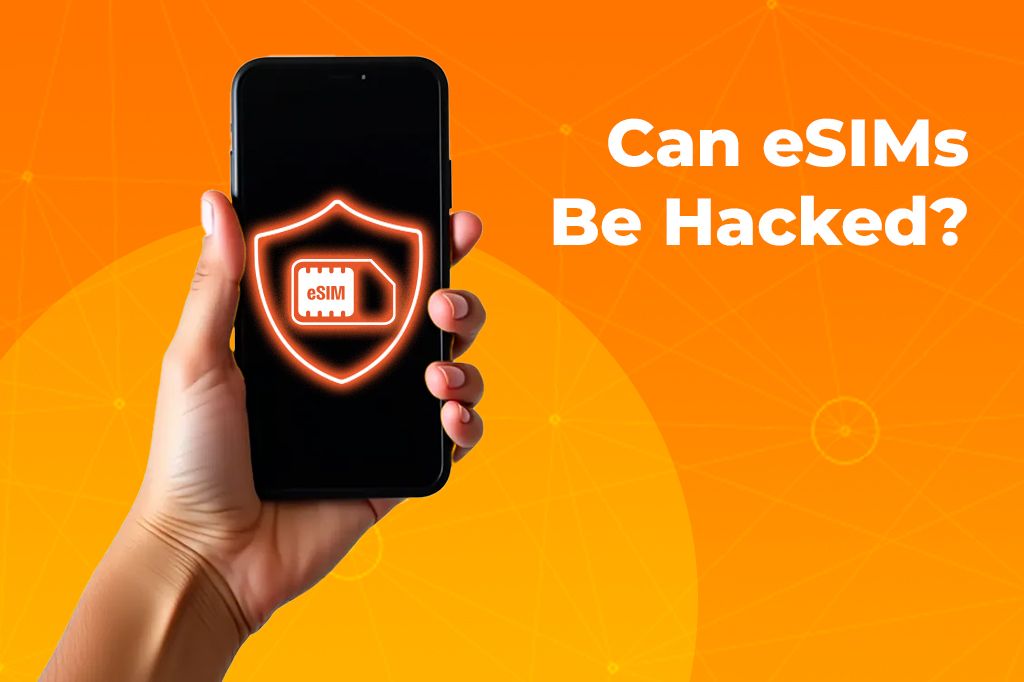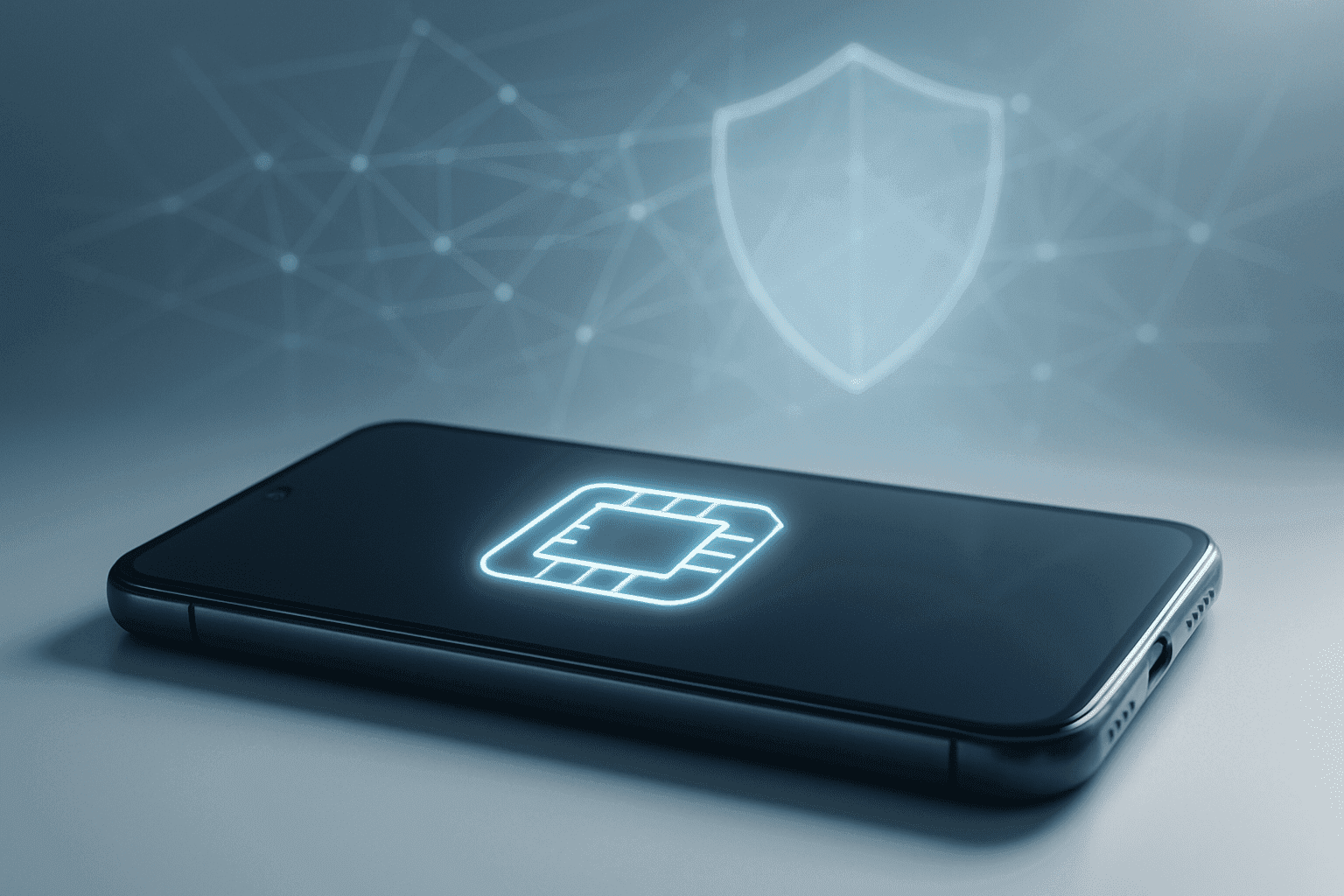More devices now come with eSIMs instead of traditional SIM cards. They’re built right into your phone, tablet, or smartwatch, which makes them very convenient, especially when you travel.
But with new tech comes new concerns. Can eSIMs be hacked? Are they really safe to use? And what risks should I watch out for?
This article will break it all down. You’ll learn how eSIMs work, what the real security risks are, and what simple steps you can take to keep your data safe.

Can eSIMs Be Hacked? Separating Myth from Reality
eSIMs, or embedded Subscriber Identity Modules, are designed with strong security in mind. Think of them as having a tiny digital vault built into your device. This vault uses powerful encryption, which is like a secret code, to protect your information. The eSIM is also part of your device’s hardware, meaning it’s physically protected and not as easy to tamper with as a removable plastic SIM card. This built-in nature helps shield it from certain types of physical attacks. They follow global security standards set by organizations like the GSMA (Groupe Spéciale Mobile Association) to ensure they are tough to crack.
While eSIMs are generally more secure than traditional SIM cards, it’s a common misunderstanding to think they are “unhackable.” No technology is completely immune to every threat. Hackers are always trying to find new ways to get around security. The security of an eSIM also depends on the security of the device it’s in and the networks it connects to. So, while they offer a big step up in security, they are not a magic shield.
Imagine a secure bank vault with thick steel doors and complex locks. It’s designed to be almost impossible to break into. However, if a very clever thief finds an overlooked weakness, perhaps in the ventilation system, or if someone with inside access is tricked or forced to help, the vault could still be compromised. The same principle applies to eSIMs; they are very secure, but not beyond every imaginable threat.

The Top eSIM Hacking Threats and Attack Methods
While directly “hacking” the eSIM chip itself is very difficult due to its design, attackers usually focus on other weak points in the system to gain control or access your eSIM profile.
- SIM/eSIM Swapping: SIM swapping, which also applies to eSIMs, is where a hacker convinces your mobile phone company (your carrier) to transfer your phone number to a SIM card or eSIM profile they control. They might do this by impersonating you, using stolen personal information to answer security questions, or sometimes by bribing a carrier employee.
This kind of attack isn’t just theoretical. It’s already happened to high-profile individuals. In September 2023, Ethereum co-founder Vitalik Buterin had his X (formerly Twitter) account hijacked after attackers persuaded his carrier to perform a SIM swap. Once they controlled his number, they tweeted a bogus NFT giveaway link that siphoned about $690,000 in crypto from followers.
- Malware & Phishing: Malware and phishing are common ways hackers try to get your information. If malware infects your phone, it could potentially steal sensitive data that helps a hacker take over your eSIM profile. Phishing scams might trick you into visiting a fake website that looks like your carrier’s site, asking for your login details.
A real-world example of how dangerous this can be is “BRATA” Android banking trojan resurfaced in mid-2022 with new features that grant it full remote-access control over phones. It spreads via SMS links posing as bank security alerts; once installed, it can record the screen, intercept every incoming text message (including carrier OTPs), and even trigger a factory reset to wipe evidence. With that deep-level access, attackers could capture the credentials needed to request an eSIM transfer or port-out.
-
Fake eSIM QR Codes: Setting up an eSIM often involves scanning a QR code. Hackers can create fake QR codes that look legitimate. If you scan one, you might accidentally install a malicious profile that doesn’t connect you to your proper carrier, or it might redirect your data through the hacker’s servers. Be very careful about where you get QR codes. Only use codes directly from your trusted carrier or eSIM provider. Be suspicious of unsolicited QR codes sent via email or found on random websites.
-
Firmware & Memory Exploits: Your phone’s firmware is the basic software that makes its hardware work. If there are security holes (vulnerabilities) in the firmware or how the device manages its memory, a skilled hacker could potentially exploit these to gain deep access to the device. Some overlooked risk factors are not updating your phone’s operating system and firmware regularly is a big risk. These updates often include patches for security vulnerabilities. Another risk is downloading apps from unofficial app stores, as these might contain hidden exploits.
-
Man-in-the-Middle Attacks: Imagine you’re sending a letter, and someone intercepts it, reads it, and then sends it on without you knowing. A Man-in-the-Middle (MitM) attack is similar, but for digital information. If you’re setting up your eSIM or managing your account on an unsecured public Wi-Fi network, a hacker on the same network could potentially intercept the data being sent between your phone and your carrier. Here we share this practical guide on how to use public Wi-Fi safely.
-
Carrier Breaches: Sometimes, the weakness isn’t your phone or your actions, but your mobile carrier. If a carrier suffers a data breach, hackers might steal customer databases. This information could include details about your account and potentially even data related to eSIM profiles (like activation codes or management credentials). This stolen data can then be used for SIM swapping or other identity theft schemes.

The Real Impact of eSIM Hacks
Once a hacker gains access through an eSIM hack, they can cause significant damage. For example, they could:
-
Intercept two-factor authentication (2FA) codes sent via SMS, giving them access to your email, bank accounts, social media, and other online services.
-
Make calls and send messages impersonating you, potentially scamming your contacts or spreading misinformation.
-
Access personal data stored in accounts linked to your phone number.
-
Commit financial fraud by accessing your banking apps or making unauthorized purchases.
-
Lead to identity theft, where they use your stolen information to open new accounts or commit crimes in your name.
These aren’t just theoretical risks. In one high-profile case, U.S. prosecutors in February 2024 linked a SIM-swapping group known as the “Powell Crew” to the theft of $400 million from crypto exchange FTX in late 2022. Investigators say the group used fake IDs to hijack an AT&T employee’s phone number, then intercepted one-time passcodes to unlock digital wallets.
The incident shows just how dangerous and costly SIM-swap attacks can be, especially when they hit companies already under pressure.
How These Risks Could Affect You
SIM cloning or eSIM hacking isn’t just a technical issue, it can have real, personal consequences. The effects can vary depending on who you are and how you use your phone. For example:
-
Business Owners: A hacked eSIM could lead to the loss of sensitive client data, unauthorized access to business bank accounts, or damage to the company’s reputation. Imagine client communications being intercepted or confidential business deals being exposed.
-
Travelers: If your eSIM is compromised while abroad, you could lose your primary means of communication, have trouble accessing travel bookings or banking apps, and face difficulties contacting your carrier for help.
-
Tech-Savvy Individuals: While often more aware of risks, tech-savvy users might use their phone number for many critical online services. A compromise could be particularly devastating if it bypasses their otherwise strong security measures (if they rely too heavily on SMS 2FA, for instance).

How to Detect an eSIM Hack: Key Signs You Shouldn’t Ignore
Knowing what to look for can help you act quickly if you suspect your eSIM has been compromised.
-
Sudden Loss of Service or Login Issues: The most obvious sign is a sudden loss of mobile service on your device. If your phone abruptly shows “No Service” or “SOS only” when you should have a signal, and restarting doesn’t help, it could mean your eSIM profile has been deactivated or transferred.
-
Security Alerts and Unusual Activity: Pay attention to:
-
Unexpected security alerts from your bank, email, or social media accounts about login attempts or password changes you didn’t make.
-
Receiving 2FA codes you didn’t request. T
-
Unusual charges on your phone bill or linked financial accounts.
-
Posts made from your social media accounts that you didn’t write.
-
Emails sent from your account that you don’t recognize.
What to Do If You Suspect SIM Fraud
-
Contact your mobile carrier IMMEDIATELY: Tell them you suspect your eSIM/SIM has been fraudulently swapped or compromised.
-
Change passwords: Start with your most critical accounts: email, banking, and any account linked to your phone number for recovery.
-
Review account activity: Check your bank, email, and social media for any unauthorized transactions or activity.
-
Notify your contacts: Warn friends and family that your number/accounts might be compromised, so they don’t fall for scams sent in your name.
-
Scan your device for malware: Use a reputable mobile security app.
-
Report it: Consider reporting the incident to relevant authorities, like the police or a consumer protection agency.
Best Practices to Secure Your eSIM Profile
Prevention is always better than a cure. Here’s how you can boost your eSIM security:
-
Update Your Device & eSIM Firmware: Your phone’s manufacturer and carrier regularly release updates for the operating system and sometimes for the eSIM firmware itself. These updates often contain crucial security patches that fix newly discovered vulnerabilities.
-
Use Strong Passwords & Multi-Factor Authentication: Protect your mobile carrier account with a strong, unique password. For all your online accounts, enable multi-factor authentication (MFA). While SMS-based 2FA is better than nothing, it’s vulnerable to SIM/eSIM swapping.
-
Beware of Phishing & Suspicious Links: Be skeptical of unsolicited emails, text messages, or calls asking for personal information, login details, or for you to scan a QR code. Never click on suspicious links or download attachments from unknown senders.
-
Trustworthy eSIM Providers: When getting an eSIM, especially for travel, stick to well-known, reputable carriers and eSIM providers as Yoho Mobile. Buying from obscure or unverified websites can be risky. They might sell you faulty profiles, misuse your payment information, or even provide QR codes that compromise your device.
Prevention is always better than a cure. Take, for instance, what happened to a T-Mobile subscriber on Christmas Eve 2023. He noticed one-time PIN texts he hadn’t requested. He called the carrier five times, insisting a SIM swap was underway, and activated a temporary account freeze while switching all key logins to an authenticator app. When service briefly dropped, he already had T-Mobile on the line, so the rogue eSIM profile was rolled back within minutes, and the attacker never reached his Wells Fargo account.

The Future of eSIM Security: What’s Next?
Looking ahead, scientists are working on even stronger types of encryption. Quantum computers, while still mostly in development, could one day break today’s standard encryption. “Post-quantum cryptography” refers to new encryption methods designed to be secure even against future quantum computers.
eSIM technology isn’t static. The GSMA and device manufacturers are constantly working to improve security standards and features. This includes things like more secure remote provisioning, better authentication methods, and faster responses to newly discovered threats. As hackers develop new attack methods, eSIM security will adapt to counter them.
Even the most advanced tech can’t protect us if we’re careless with passwords, fall for phishing scams, or ignore software updates. So while the technology keeps evolving, our role is to stay informed and practice smart digital habits. If you’re curious about how eSIMs work in practice, trying a free eSIM trial with Yoho Mobile is a simple, risk-free way to explore the tech firsthand, while keeping security top of mind. If you want to get your eSIM plan afterwards, use the code YOHO12 at checkout for a 12% discount!
Overlooked FAQs & Additional Insights
Can eSIMs be cloned?
No. True one-to-one cloning is virtually impossible because each eSIM’s cryptographic keys are locked to secure hardware. Most “eSIM hacks” involve transferring the profile to another device (SIM-swap) or breaching the carrier account, not duplicating the chip itself.
What happens if my eSIM is hacked while traveling internationally?
Immediately contact your home carrier over Wi-Fi to suspend the line, switch to a backup physical SIM or spare eSIM if you have one, and change critical passwords. Warn key contacts, watch financial accounts, and—before any trip—secure your carrier login with a strong password and app-based (non-SMS) 2FA.
Are eSIMs safer for children and elderly people?
Yes. Embedded chips are hard to lose, enable easy remote setup, and can support robust parental controls. But, both groups may still fall for phishing links or fake QR codes, and restoring an eSIM after device loss or damage can be harder than swapping a physical SIM.
